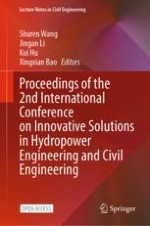Fly ash, mineral powder and wet carbide slag are industrial solid wastes, and improper treatment will cause environmental pollution. At present, the harmless treatment of industrial solid waste has become one of the problems that need to be solved when China implements “double carbon” measures. If it can be prepared into pavement base material, it can not only effectively solve the environmental pollution and ecological damage caused by a large number of solid wastes, but also provide a large number of raw materials for highway construction, and make solid wastes play a greater utilization value.
The comprehensive utilization of solid waste materials in road engineering is a research hotspot at present [
1]. In 1980s, fly ash-coal gangue mixture was used in road base and subbase in the United States, and its application effect was confirmed by testing. Since the twenty-first century, the United States has mixed iron tailings crushed stone into building materials as the subbase and subgrade of asphalt concrete pavement, and achieved good application results [
2]. In 2014, an airstrip was built with geopolymer concrete at West Wellcamp Airport in Brisbane, Australia [
3]. In recent years, Shen [
4] obtained the best mix ratio of steel slag, fly ash and phosphogypsum as road base materials, and found that its early strength was higher than that of lime-fly ash and lime-soil pavement base materials, and its long-term strength was much higher than that of cement stabilized aggregate, which could meet the relevant requirements of pavement base materials. Arulrajah [
5] found that fly ash, slag and calcium carbide residue can be used to stabilize recycled building materials as road base or subbase through unconfined compression strength and compression rebound modulus tests. Hu [
6] discussed the possibility of using fly ash and red mud geopolymer as the cementing material of crushed stone aggregate through unconfined compression strength, failure strain and drying shrinkage tests. The results showed that geopolymer stabilized aggregate had a stable application prospect in the application of flexible pavement. In China, the research on resource utilization of industrial solid waste started late. In 1990s, Maanshan Mine Research Institute applied iron tailings to pavement materials [
7]. Chang’an University mixes lime and coal gangue with soil and uses it for road base [
8]. In 1997, China built the first steel slag asphalt pavement test section [
9]. In recent years, Beijing Research Institute of Mining and Metallurgy and Guangxi Pingguo Aluminum Company jointly developed a new type of red mud road base with good road performance using lime, fly ash, red mud and some additives as raw materials, which filled a domestic gap [
10‐
12]. Qin and Liang [
13] have also carried out the research on replacing part of cement with red mud and applied it in cement stabilized macadam base, which has certain reference value for the development of new materials for road base. Wang [
14] through the tests of mechanical properties and crack resistance of cement stabilized macadam with three types of aggregate gradation, three cement dosages and fly ash, the results show that after adding fly ash, the early unconfined compression strength, flexural strength and splitting strength of cement stabilized macadam decrease, which helps to reduce early cracks. Xu [
15] found that adding fly ash and slag to cement stabilized macadam can improve the mechanical properties and shrinkage characteristics of cement stabilized macadam through unconfined compression strength, indirect tensile strength. Chu [
16] comprehensively analyzed the road performance of cement stabilized macadam mixture with iron tailings, and found that the addition of iron tailings can improve the unconfined compression strength, indirect tensile strength, water stability and frost resistance of cement stabilized macadam mixture. Liu [
17] found that the mechanical properties of slag-based polymer and fly ash stabilized macadam are better than those of cement stabilized macadam in unconfined compression strength, splitting strength, compression rebound modulus.
Although some scholars and engineering units have carried out research and engineering demonstration on the preparation of pavement base materials from solid wastes, there are few technical researches on the preparation of pavement base materials from solid wastes at home and abroad based on the principle of geopolymer. In this paper, geopolymer cementitious materials prepared from fly ash, mineral powder and wet carbide slag by alkali excitation are used to replace part of cement stabilized macadam. The mechanical properties are evaluated by unconfined compression strength, indirect tensile strength, compression rebound modulus and scour resistance. The mineral composition of raw materials and microstructure changes of samples at different ages are analyzed by XRD analysis and SEM test, and the formation mechanism of geopolymer strength is analyzed, which provides a new method for comprehensive utilization of solid waste materials.
